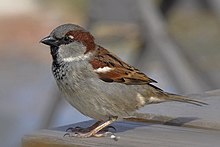Pygostylia
| Pygostylians | |
|---|---|

| |
| Fossil pygostylian ( Confuciusornis sanctus )
| |

| |
| House sparrow (Passer domesticus) | |
| Scientific classification | |
| Domain: | Eukaryota |
| Kingdom: | Animalia |
| Phylum: | Chordata |
| Clade: | Dinosauria |
| Clade: | Saurischia |
| Clade: | Theropoda |
| Clade: | Avialae |
| Clade: | Avebrevicauda |
| Clade: | Pygostylia Chatterjee, 1997 |
| Subgroups[2] | |
Pygostylia is a group of
Definition
The group Pygostylia was intended to encompass all avialans with a short, stubby tail, as opposed to the longer, unfused tails of more primitive species like
Cladogram following the results of a phylogenetic study by Jingmai O'Connor and colleagues in 2016:[2]
| Pygostylia |
| |||||||||||||||
In 2023, Li et al recovered their new taxon,
| Avialae |
| |||||||||||||||||||||||||||||||||
Description
Chiappe noted that under his definition, all members of the Pygostylia share four
The pygostylians fall into two distinct groups with regard to the pygostyle. The Ornithothoraces have a
The earliest known member of the group is the
References
- .
- ^ a b O’Connor, J.K., Wang X., Zheng X., Hu H., Zhang X., & Zhou Z. (2016). An Enantiornithine with a Fan-Shaped Tail, and the Evolution of the Rectricial Complex in Early Birds. Current Biology, 26(1): 114-119.
- ^ Chatterjee, S. 1997. The Rise of Birds. Baltimore: Johns Hopkins University Press. 312 pp.
- ^ a b Chiappe, Luis (2001). Chiappe, Luis; Witmer (eds.). Basal bird phylogeny in Mesozoic Birds: above the heads of dinosaurs. University of California Press.
- .
- ^ Gauthier, J., & De Queiroz, K. (2001). Feathered dinosaurs, flying dinosaurs, crown dinosaurs, and the name" Aves. New perspectives on the origin and early evolution of birds, 7-41.
- .
- .
- S2CID 255472056.
- ^ Holtz, Thomas R. Jr. (2012) Dinosaurs: The Most Complete, Up-to-Date Encyclopedia for Dinosaur Lovers of All Ages, Winter 2011 Appendix.
